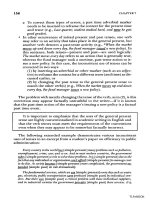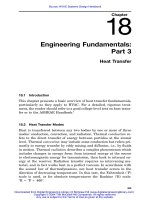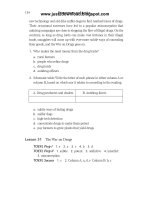MARKETING RESEARCH PART 18 doc
Bạn đang xem bản rút gọn của tài liệu. Xem và tải ngay bản đầy đủ của tài liệu tại đây (559.52 KB, 49 trang )
Determining and
Interpreting Associations
Among Variables
Ch 18 2
Associative Analyses
•
Associative analyses:
determine
where stable relationships exist
between two variables
•
Examples
–
What methods of doing business are
associated with level of customer satisfaction?
–
What demographic variables are associated
with repeat buying of Brand A?
–
Is type of sales training associated with sales
performance of sales representatives?
–
Are purchase intention scores of a new product
associated with actual sales of the product?
Ch 18 3
Relationships Between Two
Variables
•
Relationship:
a consistent, systematic
linkage between the levels or labels for
two variables
•
“Levels”
refers to the characteristics of
description for interval or ratio scales…the
level of temperature, etc.
•
“Labels”
refers to the characteristics of
description for nominal or ordinal scales,
buyers v. non-buyers, etc.
•
As we shall see, this concept is important
in understanding the type of relationship…
Ch 18 4
Relationships Between Two
Variables
•
Nonmonotonic:
two variables are
associated, but only in a very general
sense; don’t know “direction”
of
relationship, but we do know that the
presence (or absence) of one variable is
associated with the presence (or
absence) of another.
•
At the presence of breakfast, we shall
have the presence of orders for coffee.
•
At the presence of lunch, we shall have
the absence of orders for coffee.
Ch 18 5
Nonmonotonic Relationship
Ch 18 6
Relationships Between Two
Variables
•
Monotonic:
the general direction of a
relationship between two variables is
known
– Increasing
– Decreasing
•
Shoe store managers know that there is
an association between the age of a child
and shoe size. The older a child, the
larger the shoe size. The direction is
increasing, though we only know general
direction, not actual size.
Ch 18 7
Monotonic Increasing
Relationship
Ch 18 8
Relationships Between Two
Variables
•
Linear:
“straight-line”
association
between two variables
•
Here knowledge of one variable will
yield knowledge of another variable
•
“100 customers produce $500 in
revenue at Jack-in-the-Box”
(p. 525)
Ch 18 9
Relationships Between Two
Variables
•
Curvilinear:
some smooth curve
pattern describes the association
•
Example: Research shows that job
satisfaction is high when one first
starts to work for a company but goes
down after a few years and then back
up after workers have been with the
same company for many years. This
would be a U-shaped relationship.
Ch 18 10
Characterizing Relationships
Between Variables
1.
Presence:
whether any systematic
relationship exists between two
variables of interest
2.
Direction:
whether the relationship
is positive or negative
3.
Strength of association:
how strong
the relationship is: strong?
moderate? weak?
•
Assess relationships in the order
shown above.
Ch 18 11
Cross-Tabulations
•
Cross-tabulation:
consists of rows and
columns defined by the categories
classifying each variable…used for
nonmonotonic
relationships
•
Cross-tabulation table:
four types of
numbers in each cell
– Frequency
– Raw percentage
– Column percentage
– Row percentage
Ch 18 12
Cross-Tabulations
•
Using SPSS, commands are
ANALYZE, DESCRIPTIVE
STATISTICS, CROSSTABS
•
You will find a detailed discussion of
cross-tabulation tables in your text,
pages 528-531.
Ch 18 13
Cross-Tabulations
Ch 18 14
Cross-Tabulations
•
When we have two nominal-scaled
variables and we want to know if
they are associated, we use cross-
tabulations to examine the
relationship and the Chi-Square test
to test for presence of a systematic
relationship.
•
In this situation: two variables, both
with nominal scales, we are testing
for a nonmonotonic
relationship.
Ch 18 15
Chi-Square Analysis
•
Chi-square (X2) analysis:
is the
examination of frequencies for two
nominal-scaled variables in a cross-
tabulation table to determine whether
the variables have a significant
relationship.
•
The null hypothesis is that the two
variables are not related.
•
Observed and expected frequencies:
Ch 18 16
Cross-Tabulations
•
Example: Let’s suppose we want to
know if there is a relationship
between studying and test
performance and both of these
variables are measured using
nominal scales…
Ch 18 17
Interpreting a Significant
Cross-Tabulation Finding
•
If the chi-square analysis determines
that you have a significant
relationship (no support for the null
hypothesis) you may use the
following to determine the nature of
the relationship:
– The column percentages table or
– The raw percentages table
Ch 18 18
Cross-Tabulations
•
Did you study for the midterm test? __yes
__no
•
How did you perform on the midterm test?
__pass __fail
•
Now, let’s look at the data in a
crosstabulation
table:
Did You Study for the Test? * How Did You Perform on the
Test? Crosstabulation
Count
77 2 79
3 18 21
80 20 100
Yes
No
Did You Study
for the Test?
Total
Pass Fail
How Did You Perform
on the Test?
Total
Ch 18 19
Cross-Tabulations
•
Do you “see”
a relationship? Do you “see”
the
“presence”
of studying with the “presence”
of
passing? Do you “see”
the “absence”
of
passing with the presence of not studying?
•
Congratulations! You have just “seen”
a
nonmonotonic
relationship.
Did You Study for the Test? * How Did You Perform on the
Test? Crosstabulation
Count
71 6 77
7 16 23
78 22 100
Yes
No
Did You Study
for the Test?
Total
Pass Fail
How Did You Perform
on the Test?
Total
Ch 18 20
Cross-Tabulations
•
Bar charts can be used to “see”
nonmonotonic
relationships.
Did You Study for the Test?
NoYes
Count
100
80
60
40
20
0
How Did You Perform
Fail
Pass
Ch 18 21
Cross-Tabulations
•
But while we can “see”
this
association, how do we know there is
the presence of a systematic
association? In other words, is this
association statistically significant?
Would it likely appear again and
again if we sampled other students?
•
We use the Chi-Square test to tell us
if nonmonotonic
relationships are
really present.
Ch 18 22
Cross-Tabulations
•
Using SPSS, commands are
ANALYZE, DESCRIPTIVE
STATISTICS, CROSSTABS and
within the CROSSTABS dialog box,
STATISTICS, CHI-SQUARE.
Ch 18 23
Chi-Square Analysis
•
Chi-square analysis:
assesses
nonmonotonic
associations in cross-
tabulation tables and is based upon
differences between observed and
expected frequencies
•
Observed frequencies:
counts for
each cell found in the sample
•
Expected frequencies:
calculated on
the null of “no association”
between
the two variables under examination
Ch 18 24
Chi-Square Analysis
•
Computed Chi-Square values:
Ch 18 25
Chi-Square Analysis
•
The chi-square distribution’s shape
changes depending on the number of
degrees of freedom
•
The computed chi-square value is
compared to a table value to
determine
statistical
significance









